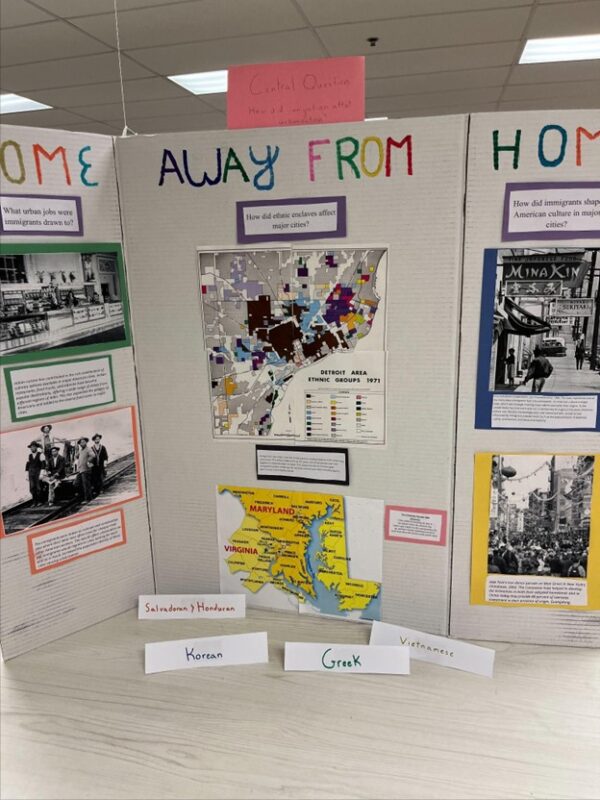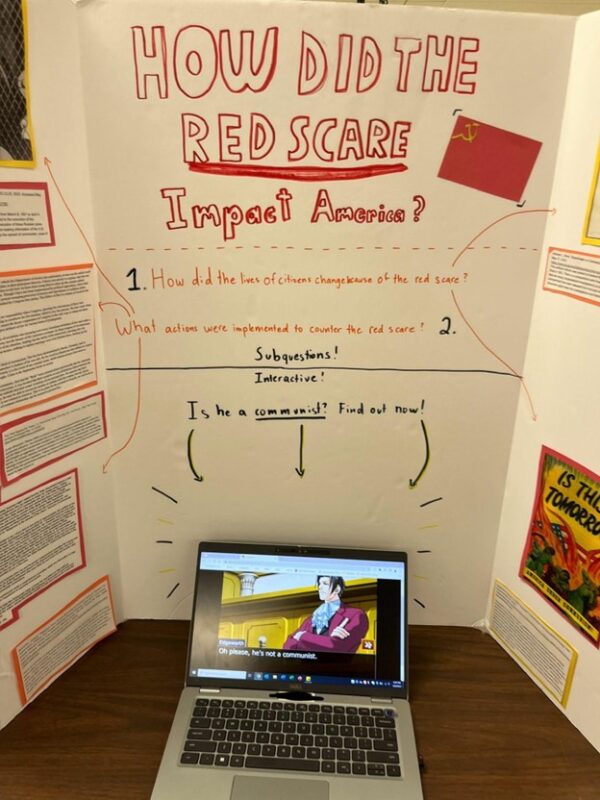Let them be historians: public history with Fairfax High School and the DAR Museum
07 April 2025 – Kevin Lukacs and Michelle Lukacs
During the 2022-2023 school year, a history teacher from Fairfax High School (FHS) in Fairfax, Virginia, and the Curator of Education at the Daughters of the Revolution (DAR) Museum in Washington, D.C, teamed up to create a six-week project for Advanced Placement (AP) U.S. History students. This project addressed professional goals and concerns for both secondary education and museum outreach, aiming to help students become more critical and conscious consumers of history by teaching them the tools of historical work–not just content.

The students’ interactive sought for relevancy by highlighting ethnic enclaves within the greater D.C. area that students may or may not have been familiar with. Image credit: Kevin Lukacs, June 8, 2023.
Michelle and Kevin Lukacs met in graduate school in 2017 and have collaborated on several classroom projects that evolved into this endeavor. The student project was to create a museum exhibit based on material history and a point of interest from the past year’s curriculum. Students created a central research question and three sub-questions/themes to guide their research. They researched online and selected 3-5 objects from various museums to feature and incorporated an interactive element. At the end, students exhibited their posters with object images and label text at the high school and invited parents and community members for an after-hours experience.
To gain insight into exhibit practices, students attended a field trip to the National Museum of American History (NMAH) and received coaching from two DAR Museum staff. Educators at FHS, led by Michelle Lukacs, exposed students to examples of primary sources and exhibit label guidelines, engaging with important “So What?” questions in American history. The topics were gentrification, disability history, and women’s rights. The exposure to museum professionals made transparent the work required to create an exhibition, empowering students to develop similar approaches for their own projects. The project also filled an important curriculum gap for teachers. After the AP test, there are six weeks before the end of the school year. Filling this time in a way that will keep students engaged and provide a meaningful experience is a critical challenge for AP educators.
While at NMAH, students were expected to complete a worksheet to help them critically analyze and consider how they would create their own exhibits. Students thoughtfully considered titles, donor panels, the layout of sections and organization of objects, and critiqued content and interactives as a group.
Two DAR Museum professionals met with the students. Curator of Exhibitions William Strollo met with them prior to their field trip to NMAH to discuss the logistics of planning an exhibit and answer their questions. Coaching sessions from Curator of Education Kevin Lukacs took place over four days at Fairfax High School, with Kevin spending a whole class period with each section of AP US History. Coaching began with a class warmup in the form of an “Object Lesson,” modeling how to engage audiences with narrative and meaning through material history. As Kevin worked individually with each group, the goal was to have a spirited conversation about their projects, finding deeper meaning and seeking creative solutions to interactives or lay out. A key principle was to not give students solutions to every problem, but to give them tools and examples that would help them find their own way. Tools included online databases, oral histories, or examples of museum interactives we had seen in person or online. The students were tremendously capable and passionate across the board, they just needed support and encouragement.

This student group modified an existing video game, Ace Attorney, to simulate a more whimsical take on the McCarthy hearings. Image credit: Kevin Luckas, June 8, 2023.
The final exhibits ran the gamut of creative displays. One student group created a cardboard printing press as an immersive element to an exhibit on the American Revolution. Another exhibited the Americans with Disabilities Act of 1990. Displays included conspiracy-style yarn maps with redacted text, scale models of Hoovervilles, and city backdrops to accompany text on the garment industry in twentieth-century New York City.
The projects were exhibited so each class could walk through and view each other’s work. Classes were divided into rotations. The first half stood next to their exhibit to answer questions while the other half walked around and enjoyed the displays. During this time, teachers graded the projects using a standard rubric. Students were graded on inclusion of a title and introduction, use of objects, an interactive element, bibliography, and overall organization and effectiveness. The interactive elements were inspiring. One group labeled Jenga pieces with Intolerable Acts, with each piece removed being one step closer to revolution. Others created video games, quizzes, or small boats from which to throw crates of English tea. One project examined feminist music from marching songs to Taylor Swift and set up a piano with labeled keys and sheet music downloaded from the Library of Congress. Museum professionals and exhibit designers could take notes from the creativity and earnest engagement these students created. Teachers also participated in Q&A’s to fully understand intention and execution.
School administration arranged to open the building in the evening during the week of presentations to enable students to bring their families and communities to enjoy the exhibits. Parents and administrators appreciated the opportunity to celebrate the students’ academic achievements the same way that they would celebrate sporting events. Several projects were also exhibited at the DAR Museum during Continental Congress, the DAR’s annual national meeting.
The goal of this project was to provide students with an engaging and insightful avenue to present their own historical interpretations of a topic of interest. Students were able to revisit subjects of personal value. This culminating project exemplified two of the school district’s focuses—project based assessments and culturally responsive teaching—which center classroom learning on student agency.

The creative use of a conspiracy yarn map and redacted manila folders offered an intriguing design that created a visual flow between exhibit text. Image credit: Kevin Lukacs, June 8, 2023.
A critical part of the DAR Museum’s forthcoming strategic plan is community outreach, connecting to stakeholders throughout the Washington DC, Maryland, and Virginia region, including schools. Since the building is unable to host large groups of students, the museum uses robust digital tools, online object-based activities and games, and sends museum staff out to communities. DAR members and executives praised the creativity and commitment to community outreach.
This project furthers many of the ideological goals of public history. It engages students with the tools of history (critical thinking, research, writing, creativity) instead of focusing purely on content knowledge acquisition. Kevin’s explicit goal was to help students become more critical consumers of history by questioning exhibit stakeholders, primary source utilization, and identifying curatorial silences.
This project was the culmination of years of effort on the part of Kevin and Michelle. Michelle has been working to greatly increase project-based learning at every school where she has taught. Students deserve to work on projects that feel relevant, transformative, and provide an end result they will be proud of. Kevin has worked to bring student-led programs and community initiatives to museums that listen to the needs of educators and students. It all starts from conversations with our networks and communities and can grow to something that produces real impact and good work.
While partnerships can seem daunting, Michelle would encourage museums and teachers to keep reaching out to each other. By engaging students in historical research and helping them create final products of which they can be proud, students collaborate, engage with historiography, and learn historical literacy, making them better consumers of history and information. In other words . . .
Let them be historians. That’s what public history is all about.
~Michelle Lukacs is an experienced teacher and passionate historian who melds these interests together in her education/history blog, UStories. Her Instagram handle is: @us.tories
~Kevin Lukacs is the Curator of Education at the DAR Museum. He is obsessed with the Mothman, the historical relevance of horror films and literature, and using comic books to connect audiences to the past and advocate for a better future.




What a wonderful project. The two of you worked so hard and deserve high praise for your efforts and end results.